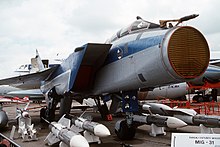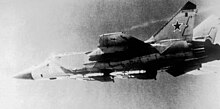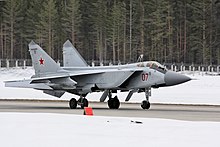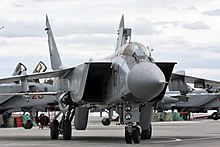Mikoyan MiG-31
| MiG-31 | |
|---|---|

| |
| Russian Air Force MiG-31 in flight | |
| Role | Interceptor aircraft |
| Manufacturer | Mikoyan |
| First flight | 16 September 1975 |
| Introduction | 6 May 1981 |
| Status | In service |
| Primary users | Russian Air Force Kazakhstan Air Force |
| Number built | approx. 400[1] /500[2][3] |
| Developed from | Mikoyan-Gurevich MiG-25 |
The Mikoyan MiG-31 (Russian: Микоян МиГ-31; NATO reporting name: Foxhound) is a supersonic interceptor aircraft developed to replace the MiG-25 "Foxbat". The MiG-31 was designed by the Mikoyan design bureau based on the MiG-25.[4]
Development
The MiG-25, despite Western panic about its tremendous performance, made substantial design sacrifices in capability for the sake of achieving high speed, altitude, and rate of climb. It lacked maneuverability at interception speeds and was difficult to fly at low altitudes. The MiG-25's speed was limited to Mach 2.83 in operations, but it could reach a maximum speed of Mach 3.2 or more with the risk of damaging the engines beyond repair.[5][6]
Development of the MiG-25's replacement began with the Ye-155MP (Russian: Е-155МП) prototype which first flew on 16 September 1975.[7] Although it bore a superficial resemblance to a stretched MiG-25 with a longer fuselage for the radar operator cockpit, it was in many respects a new design. The MiG-25 used 80% nickel steel in its structure to allow welding.[8]
The most important development was introducing an advanced radar capable of both look-up and look-down engagement (locating targets above and below the aircraft), as well as multiple target tracking. This finally gave the Soviets an interceptor able to engage the most likely Western intruders at long range.[citation needed]

Like its MiG-25 predecessor, the MiG-31 was surrounded by early speculation and misinformation concerning its design and abilities. The West learned of the new interceptor from Lieutenant Viktor Belenko, a pilot who defected to Japan in 1976 with his MiG-25P. Belenko described an upcoming "Super Foxbat" with two seats and an ability to intercept cruise missiles. According to his testimony, the new interceptor was to have air intakes similar to the Mikoyan-Gurevich MiG-23, which the MiG-31 does not have, at least not in production variants.[citation needed]
A-50 and MiG-31 can automatically exchanged with each other and terrestrial radar target designation.[9]
Some upgrade programs have found their way in the MiG-31 fleet, like the MiG-31BM multirole version with upgraded avionics, new multimode radar, hands-on-throttle-and-stick (HOTAS) controls, liquid crystal (LCD) color multi-function displays (MFDs), ability to carry the Vympel R-77 missile and various Russian air-to-ground missiles (AGMs) such as the Kh-31 anti-radiation missile (ARM), a new and more powerful computer, and digital data links.[10] A project to upgrade the Russian MiG-31 fleet to the MiG-31BM standard was begun in 2010;[11] 60 or more aircraft are to be upgraded to MiG-31BM standard by 2020.[12]
Replacement
Russia hopes to field a replacement for the MiG-31 by 2020, with all aircraft retired by 2028. Development of a new aircraft has begun. Development of a new interceptor is favored over restarting MiG-31 production.[13]
Design
Like the MiG-25, MiG-31 is a large twin-engine aircraft with side-mounted air intakes, a shoulder-mounted wing with an aspect ratio of 2.94, and twin vertical tailfins. Unlike the MiG-25, it has two seats, with the rear occupied by a dedicated weapon systems officer.[citation needed]
Airframe and engines

The wings and airframe of the MiG-31 are stronger than those of the MiG-25, permitting supersonic flight at low altitudes. Its D30-F6 jet engines, each rated at 152 kN thrust, allow a maximum speed of Mach 1.23 at low altitude. High-altitude speed is temperature-redlined to Mach 2.83—the thrust-to-drag ratio is sufficient for speeds in excess of Mach 3, but such speeds pose unacceptable hazards to engine and airframe life in routine use.[5]
MiG-31 is limited to only 5 g at supersonic speeds.[5] At combat weight, its wing loading is marginal and its thrust to weight ratio is favorable. However, it is not designed for close combat or rapid turning.[5]
Electronics suite

The MiG-31 was the world's first operational fighter with a passive electronically scanned array radar (PESA), the Zaslon S-800. Its maximum range against fighter-sized targets is approximately 200 km (125 mi), and it can track up to 10 targets and simultaneously attack four of them with its Vympel R-33 missiles. The radar is matched with an infrared search and tracking (IRST) system in a retractable undernose fairing.[5]
Radars
Adopted in 1981
- the range detection of air targets: 200 km (for the purpose of with the radar cross-section of 19 m² on a collision angles with probability 0.5)
- target detection distance with radar cross-section of 3 m² in the rear within 35 km with a probability of 0.5 ([14][15])
- number of detected targets: 24
- the number of targets for attack: 8
- the range of automatic tracking: 120 km
- detection of thermal goals - 56 km
The basic differences between versions МиГ-31БМ:[16]
The onboard radar complex MiG-31БМ is capable of simultaneously detecting 24 air targets, 8 of which can be simultaneously attacked by missiles R-33S. Achieved a possibility to intercept targets flying at a speed corresponding to M=6, improved other characteristics of the complex.[citation needed]
Modernized variants of the aircraft can be equipped with radar missiles Kh-31S, Kh-25MP or Kh-25МПУ (up to six units), anti-ship UR Kh-31A (up to six), class missiles air-to-surface Kh-29 and Kh-59 (up to three) or X-59M (up to two units), up to six corrected air bombs KAB-1500 or eight KAB-500 with television or laser-guided. Maximum mass of payload is to 9000 kg.[citation needed]
The MiG-31M-, MiG-31D-, and MiG-31BS-standard aircraft have an upgraded Zaslon-M radar, with larger antenna and greater detection range (said to be 400 km (250 mi) against AWACS-size targets) and the ability to attack multiple targets — air and ground — simultaneously. The Zaslon-M has a 1.4m diameter (larger) antenna, 50% to 100% better performance than Zaslon. In April 1994 it was used with an R-37 to hit a target at 300 km distance.[citation needed] It has a search range 400 km versus a 19/20 sq m RCS target and can track 24 targets at once, engaging six[17][18](282 km for 5m2[19]).
Cockpit
The aircraft is a two-seater with the rear seat occupant controlling the radar. Although cockpit controls are duplicated across cockpits, it is normal for the aircraft to be flown only from the front seat. The pilot flies the aircraft by means of a centre stick and left hand throttles. The rear cockpit has only two small vision ports on the sides of the canopy. It is argued that the presence of the WSO (Weapon Systems Operator) in the rear cockpit improves aircraft effectiveness since the WSO is entirely dedicated to radar operations and weapons deployment. This decreases the workload of the pilot and increases efficiency. Both cockpits are fitted with zero/zero ejection seats which allow the crew to eject at any altitude and airspeed.[5]
It has been claimed by Russian Federation Defence Ministry chief Colonel Yuri Balyko, that the upgrade will increase the combat effectiveness of the aircraft several times over.[20]
Armament

The MiG-31's main armament is four R-33 air-to-air missiles (NATO codename AA-9 'Amos') carried under the belly. The R-33 is the Russian equivalent of the U.S. Navy's AIM-54 Phoenix.
Unlike the MiG-25, the MiG-31 has an internal cannon, a six-barrel, 23 mm GSh-6-23 with 800 rounds of ammunition, mounted above the starboard main landing gear bay. The GSh-6-23 has a claimed rate of fire of over 10,000 rounds per minute. However, after two Su-24 were lost because of premature shell detonation in 1983, plus some different problems with gun usage (system failures, etc.), usage of the GSh-6-23 was stopped by a decision of the Soviet AF Command. The aircraft in the Russian AF were flying with fully operational guns, but without ammunition in January 2009.[21]
Operational history

The MiG-31 entered operational service with the Soviet Air Defence Forces (PVO) in 1982.[citation needed]
With the designation Ye-266, a re-engined Ye-155 shattered world records. It reached an absolute maximum altitude of 123,524 ft, or 37,650 m, and set a time to height record of 35,000 m in 4 minutes, 11.78 seconds, both which were set by test pilot Alexander Fedotov. Ostapenko, his deputy, set a record of 30,000 m in 3 minutes, 9.8 seconds.[22]
Following the collapse of the USSR in 1991, however, the budget for spares (MIG-31 AOG desk was created to solve this problem) and maintenance collapsed, leaving many squadrons unable to maintain their complex aircraft.[citation needed]
Approximately 370 are in Russian service, with another 30 or so in Kazakhstan.[23]
Export
Syria ordered eight MiG-31E aircraft in 2007 for Syrian Air Force.[24][25] However, the order has been suspended in May 2009 reportedly either due to Israeli pressure or lack of Syrian funds.[26]
Variants

A new version of the MiG-31 with upgraded avionics, the MiG-31B, was introduced in 1990. Its development was the result of the Soviet discovery that Phazotron radar division engineer Adolf Tolkachev had sold information on advanced radars to the West. Tolkachev was executed, and a new version of the compromised radar was hastily developed. Many earlier MiG-31s were upgraded to the new standard, designated MiG-31BM.[27]
Development of a more comprehensive advanced version, the MiG-31M, began in 1983 and first flew in 1986, but the dissolution of the Soviet Union prevented it from entering full production.[citation needed] The MiG-31M standard adds some additional features like Global Positioning System (GPS) and GLONASS receivers, and three color CRT MFDs in the rear cockpit.[citation needed] The upgraded MiG-31БМ maximum range detection of air targets increased to 320 km automatic tracking accepted up to ten goals, and the latest complexes of «Barrier» track up to 24 targets and simultaneously can attack up to 8 targets. On-Board computer Argon-Kresearch Institute «Argon») selects the four most important, which simultaneously are operated four missiles air-to-air long-range R-33 (R-33S). Thermal radar is interfaced radar and is designed for passive review of the airspace, and for the issuance of targeting missiles P-40TD and R-60 TGS.
Armament MiG-31M - SD six long-range P-33C and P-37, comfortably suspended under the fuselage by two in three rows, as well as four types of medium-range missiles P-77 under the wing. Gun mount abolished. Not user.[28]
The basic differences between versions МиГ-31БМ[29] (1998[30]). Really this a little AWACS airplane.
The flight-navigation equipment of the aircraft MiG-31 includes a system of automatic control system SAU-155МП and sighting-navigation complex KN-25 with two inertial systems and IP-1-72A with digital computer «Maneuver», electronic range navigation system «Radical NP (312) or A-331, electronic system of the far - navigation A-723 «Slip-2». Distant radio navigation is carried out by means of two systems: tropic» (similar to the system of «Laurent») and «Route» (similar to the system of «omega»). can detect targets at a distance of up to 320 kilometers and hit them at a distance of 280 kilometers[31].
Additional Wed-tion is detection of air targets teplopelengator 8TP (detection range - up to 50 km, the horizontal field of view ± 60 °). The MiG-31 is equipped with sr-you ECM radar and infrared ranges. [32] Interceptor MiG-31 is capable of performing combat tasks
MiG-31 was equipped with RK-RLDN and APD-518[33] digital secure datalinks. The RK-RLDN datalink is for communication with ground control centers. The APD-518 datalink enables a flight of four MiG-31 to automatically exchange radar-generated data within 200[34] km (124 mi) from each other. It also enables other aircraft with less sophisticated avionics[35], such as MiG-23,25,29/Su - 15,27[36] to be directed to targets spotted by MiG-31 (a maximum of 4 for each airplane MiG-31).
- arming - 4 long-range missiles + 4 short-range/medium-range missiles (including R-77 medium-range).[37]
- interacting with ground-based automated digital control system (ACS «Rubezh»), operating modes remote aiming, semi-automated actions (coordinate support), singly, and also:
- Digital immune system provides the automatic exchange of tactical information in a group of four interceptors, remote one from another at the distance of 200 km and aiming at the target group of fighters with less-powerful avionics (in this case the aircraft performs the role of guidance point or repeater).[38]
- Until 2000, the MiG-31 was the world's only serial fighter equipped with phased array radar.[39][40]
Notable accidents
On 6 September 2011, a MiG-31 crashed near Bolgary village, Perm region, Russia.[41] The aircraft crashed shortly after takeoff, killing both pilots. Another, non-fatal crash occurred in 2010. The entire fleet was grounded pending an investigation.[42]
During the night of 23 April 2013, a Kazakhstan Air Force MiG-31 crashed during a training flight near the village of Prostornoye in the Karaganda Region of Kazakhstan, killing the pilot and injuring the navigator. The plane crashed due to technical failure. The same plane underwent a major overhaul at a plant in Rzhev, northwest Russia in December 2012.[43]
Operators

- Current operators
 Kazakhstan
Kazakhstan
- Kazakhstan Air Force 29 in service[44]
- Russian Air Force 252 in service.[45] 122 active.[13] 10 BM in 2012 [46] +3+2=5 BM in 2013[47]
- Russian Naval Aviation 30
Former operators
- Soviet Air Defense Forces
- Soviet Air Force aircraft passed on to Russia and Kazakhstan in 1991.
Specifications (MiG-31)




Data from Great Book of Modern Warplanes,[4] MiG-31E data,[48]Combat Aircraft since 1945 [1]
General characteristics
- Crew: Two (pilot and weapons system officer)
Performance
- Thrust/weight: 0.85
- Maximum g-load: 5 g
Armament
- 1× GSh-6-23 23 mm cannon with 260 rounds.
- Fuselage recesses for 4× R-33 (AA-9 'Amos') (or for MiG-31M/BM only 6× R-37 (AA-X-13 'Arrow') long-range air-to-air missiles)
- 4 underwing pylons for a combination of (6 places for charging[49]):
- 6× R-37 long-range missiles (280km).[50]
- (4[51])× R-33 long-range missiles (304km) 2012.[52]
- (?)× Kh-31 long-range missiles (200km) for high-speed target (maneuvering with overload 8G).[53]
- (?)× Р-33 AA-9 «Amos» (1981) 120km, Р-33S (1999) 160km[54].
- 2[55]4 (superior limit)[56]× R-40TD1 (AA-6 'Acrid') medium-range missiles (P-40 (50km, MiG-25P, 1970, not user after 1999) 80km(PD)(user)), height applications between 0.5 and 30 km (maneuvering with overload 4G)[57].
- 4× R-60 (AA-8 'Aphid')
- 4× R-73 (AA-11 'Archer') short-range IR missiles,
- 4× R-77 (AA-12 'Adder') medium-range missiles (100км) for high-speed target (maneuvering with overload 12G).[58].
- Some aircraft are equipped to launch the Kh-31P (AS-17 'Krypton') and Kh-58 (AS-11 'Kilter') anti-radiation missiles in the suppression of enemy air defenses (SEAD) role.
See also
- Firefox (novel) and Firefox (film), the premise of which is the theft of a speculated/fictional version of the MiG-31
Related development
Aircraft of comparable role, configuration, and era
Related lists
References
Notes
- ^ a b Wilson 2000, p. 103.
- ^ http://www.airwar.ru/enc/fighter/mig31b.html
- ^ http://www.airwar.ru/enc/fighter/mig31.html
- ^ a b Spick 2000
- ^ a b c d e f g Dawes, Alan. "Mikoyan's Long-Legged Hunting Dog." Air International, December 2002, pp. 396–401.
- ^ Gunston and Spick 1983, pp. 132–133.
- ^ Eden 2004, p. 323.
- ^ Eden 2004, p. 308.
- ^ http://vpk-news.ru/articles/15752
- ^ "Russian air force completing MiG-31BM modernization program. Retrieved: 24 January 2011.
- ^ Skrynnikov, R. "Defense: Russian air force completing MiG-31BM modernization program." RIA Novosti, 13 August 2010. Retrieved: 17 August 2010.
- ^ Ankov, Vitaliy. "Russia to modernize 60 MiG-31 interceptors by 2020." RIA Novosti, 2 January 2012. Retrieved: 25 November 2012.
- ^ a b Russia to Field MiG-31 Replacement by 2020 - Rian.ru, April 11, 2013
- ^ armament control System SUV «Barrier» of the MiG-31
- ^ http://www.roe.ru/cataloque/air_craft/aircraft_16-19.pdf
- ^ worldweapon.ru, MiG-31БМ
- ^ Zaslon radar at Janes Defence web-site
- ^ Zaslon radar at Russia Airforce Handbook - Google Books
- ^ "Zaslon-M radar." Fighterplanes. Retrieved: 16 July 2012.
- ^ "MiG-31 Upgrade Will Quadruple Its Effectiveness – Expert." royfc.com. Retrieved: 24 January 2011.
- ^ Williams, Anthony G. "Amendments and additional notes to 'Rapid Fire'." Retrieved: 24 January 2011.
- ^ "World Records." OKB MIG. Retrieved: 11 May 2011.
- ^ "Russian Federation Air Force (RFAF) Aviatsiya Voyenno (AV)." globalsecurity.org. Retrieved: 24 January 2011.
- ^ Air Forces Monthly, August 2007 issue
- ^ Karnozov, Vladimir. "Syria signs for eight MiG-31 interceptors." Flight International, 21 June 2007.
- ^ "Syrian MiG-31 Order suspended." mosnews.com. Retrieved: 24 January 2011.
- ^ RIA Novosti "Defense: Russian air force completing MiG-31BM modernization program." RIA Novosti. Retrieved: 17 August 2010.
- ^ http://worldweapon.ru/sam/mig31.php
- ^ http://dokwar.ru/publ/vooruzhenie/aviacija_i_flot/dvukhmestnyj_sverkhzvukovoj_istrebitel_perekhvatchik_mig_31/15-1-0-271
- ^ http://www.testpilots.ru/tp/russia/mikoyan/mig/31/mig31.htm
- ^ http://lenta.ru/news/2013/04/04/mig31/
- ^ http://worldweapon.ru/sam/mig31.php
- ^ http://www.airwar.ru/enc/fighter/mig31.html
- ^ http://www.modernforces.ru/mig-31b/
- ^ http://испытатели.рф/russia/mikoyan/mig/31/bm/mig31bm.htm
- ^ http://www.arms-expo.ru/049049056052124051050056051.html
- ^ http://worldweapon.ru/sam/mig31.php
- ^ http://www.arms-expo.ru/049049056052124051050056051.html
- ^ http://militaryrussia.ru/blog/topic-407.html
- ^ http://worldweapon.ru/sam/mig31.php
- ^ Petrov, Sergei. "Flight recorder found at MiG-31 crash site." rian.ru, 7 September 2011.
- ^ "Investigators seizing crashed MiG-31 fighter documentation." itar-tass.com. Retrieved: 16 July 2012.
- ^ http://en.ria.ru/world/20130424/180814966/Pilot-Killed-in-Kazakh-MiG-31-Crash.html
- ^ http://www.flightglobal.com/airspace/media/reports_pdf/world-air-forces-2013-101015.aspx
- ^ Zelin, Alexander (Commander of the Russian Air Force). "Zelin." ng.ru. Retrieved: 19 March 2012.
- ^ http://www.arms-expo.ru/049057054048124050055057055050.html
- ^ http://bastion-karpenko.narod.ru/MiG-31_01.html
- ^ "MiG-31E." RAC MiG. Retrieved: 22 July 2008.
- ^ http://samolet-mig-31.narod.ru
- ^ http://www.airwar.ru/enc/fighter/mig31bm.html
- ^ http://www.arms-expo.ru/049049056052124051050056051.html
- ^ http://dokwar.ru/publ/aviacija_i_flot/mig_31bm_poluchat_novuju_raketu/15-1-0-583
- ^ http://dokwar.ru/publ/aviacija_i_flot/mig_31bm_poluchat_novuju_raketu/15-1-0-583
- ^ http://испытатели.рф/russia/vympel/r/33/r33_1.htm
- ^ http://www.arms-expo.ru/049049056052124051050056051.html
- ^ http://www.modernforces.ru/mig-31b/
- ^ http://испытатели.рф/russia/bisnovat/r/40/r40.htm
- ^ http://испытатели.рф/russia/vympel/r/77/r77.htm
- ^ "MiG-31E Interceptor." roe.ru. Retrieved: 16 July 2012.
Bibliography
- Eden, Paul, ed. "Mikoyan MiG-25 'Foxbat'". "Mikoyan MiG-31 'Foxhound'". Encyclopedia of Modern Military Aircraft. London: Amber Books, 2004. ISBN 1-904687-84-9.
- Gordon, Yefim. MiG-25 'Foxbat,' MiG-31 'Foxhound:" Russia's Defensive Front Line. Hinckley, UK: Midland Publishing, 1997. ISBN 1-85780-064-8.
- Spick, Mike. "MiG-31 'Foxhound'". The Great Book of Modern Warplanes. St. Paul, Minnesota: MBI, 2000. ISBN 0-7603-0893-4.
- Wilson, Stewart. Combat Aircraft since 1945. Fyshwick, Australia: Aerospace Publications, 2000. ISBN 1-875671-50-1.
External links
- MiG-31 Foxhound on fas.org
- MiG-31 page on aerospaceweb.org
- MiG-31E page on Russian Aircraft Corporation "MiG" site
- MiG-31 page on milavia.net
- MiG-31 Foxhound at Global Security
- MIG-31 Foxhound Interceptor at Russian Military Analysis
- MiG-31 on aviation.ru
- MIG-31 Foxhound at Global Aircraft
- Foxbat and Foxhound - Australian Aviation
- Износ техники — причина катастрофы МиГ-31? Template:Ru icon (in english)
